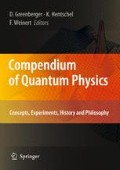In 1897, Joseph John Thomson (1856–1940) had announced the discovery of a corpuscle. Others soon called it ► electron, despite Thomson's stubborn preference for his original term, borrowed from Robert Boyle (1627–91) to denote any particlelike structure. Very soon afterwards, Thomson began to think about how to explain the periodicity of properties of the chemical elements in terms of these negatively charged corpuscles as atomic constituents. Chemical properties would thus have to depend on the number and constellations of these corpuscles inside the atom. They would have to have stable positions in it, bound by electrostatic and possibly kinetic forces. Because under normal conditions chemical atoms are electrically neutral, the total electric charge of all these negatively charged electrons had to be compensated for by an equal amount of positive charge. For Thomson it was natural to assume that this positive charge was continuously distributed throughout the atom, whose radius was estimated at the time to be around 10−12 m. The very small negatively charged electrons (contemporary estimates indicated an order of magnitude of 10−15 m) were distributed in the atom like raisins inside a cake or like plums in a pudding, whence the popular nickname for Thomson's atomic model as the “plum pudding model”.
Access this chapter
Tax calculation will be finalised at checkout
Purchases are for personal use only
Preview
Unable to display preview. Download preview PDF.
Primary Literature
Alfred M. Mayer: Floating magnets. American Journal of Science 116, 248–9 (1878), also in Nature 17, 487–488
Alfred M. Mayer: On the morphological laws of the configurations formed by magnets floating vertically and subjected to the attraction of a superposed magnet. Philosophical Magazine (5th series) 17, 98–108 (1879)
Joseph John Thomson: On the structure of the atom. Philosophical Magazine (6th series) 7, 237–265 (1904)
Joseph John Thomson: The structure of the atom (an evening lecture at the Royal Institution of London on March 10, 1905), published in the Proceedings of the Royal Institution of London (1905, 1–15)
Joseph John Thomson: The Corpuscular Theory of Matter (Constable & Company, London 1907)
Secondary Literature
Edward Arthur Davis & Elisabeth Falconer: J.J. Thomson and the Discovery of the Electron (Taylor & Francis, London 1997, esp. chap. 6, with a reprint of Thomson 1905 on pp. 215–229)
John Heilbron: J.J. Thomson and the Bohr atom. Physics Today 30, 23–30 (April 1977)
Armin Hermann (ed.): Der erste Quantenansatz für das Atom: Arthur Erich Haas (Battenberg, Stuttgart 1965) (Dokumente der Naturwissenschaft, Abt. Physik, issue 10)
Helge Kragh: The First Subatomic Explanations of the Periodic System. Foundations of Chemistry 3/2, 129–143 (2001)
Russell McCormmach: The atomic theory of John William Nicholson. Archive for History of Exact Sciences 3/2, 160–184 (1975)
Editor information
Editors and Affiliations
Rights and permissions
Copyright information
© 2009 Springer-Verlag Berlin Heidelberg
About this chapter
Cite this chapter
Hentschel, K. (2009). Atomic Models, J.J. Thomson's “Plum Pudding” Model. In: Greenberger, D., Hentschel, K., Weinert, F. (eds) Compendium of Quantum Physics. Springer, Berlin, Heidelberg. https://doi.org/10.1007/978-3-540-70626-7_9
Download citation
DOI: https://doi.org/10.1007/978-3-540-70626-7_9
Published:
Publisher Name: Springer, Berlin, Heidelberg
Print ISBN: 978-3-540-70622-9
Online ISBN: 978-3-540-70626-7
eBook Packages: Physics and AstronomyPhysics and Astronomy (R0)

